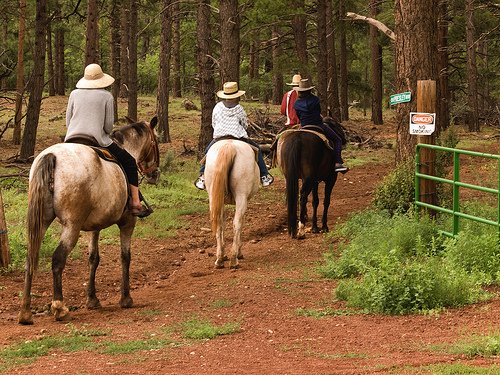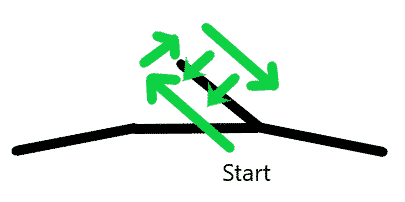

With all this “natural horsemanship” that has been a growing trend, people just love to desensitize their horses to death. They think that because their horse can stand there quietly while they crack a whip in front of his face it means he’s perfectly calm and “bomb proof.” Hate to burst your bubble, but he might just be shutting down instead of calming down. There is a huge difference. A shutdown horse will just stand there tuning out everything around him. A calm horse will relax. He may look around, shift position, and maybe even show interest in the object he is being desensitized to. He will obviously be present and paying attention. A shutdown horse will be extremely internalized and blocking everything out and he’s a ticking timebomb just waiting to explode.
Why Desensitizing Can Cause Horses to Shut Down
Horses don’t just randomly shut down. They shut down because no one is listening to them. This is probably one of the most common mistakes people make. A horse tries to communicate that he is scared of a situation, and we either ignore him or up the pressure. Then, when he reacts with his natural fight or flight instinct, we label him as a “bad horse.” He’s not necessarily being bad. He’s trying to communicate.
The Importance of Good Communication
Think about it like this, if you have a child who is afraid of the dark, are you going to lock them in a dark room to “desensitize” them to being alone in the dark? No! Of course not. At least I hope you wouldn’t. The most common solution is to give the child a nightlight. Eventually, the child will realize that there is nothing to be afraid of and the nightlight will no longer be necessary. This method allows the child to come to the conclusion that darkness isn’t scary on their own.
Similar logic can be applied to horses. Let’s say you are desensitizing your horse to cracking a whip. Conventional wisdom says that if the horse spooks when you crack the whip, don’t stop until the horse calms down. As soon as the horse stops moving his feet, stop cracking the whip. However, all the while, the horse is telling you “I am really scared of the whip!” But you’re telling him “I don’t care, just stand still and I’ll take it away.”
Horses aren’t humans. They are prey animals and they have a different thought pattern than we do. He can’t understand that you are trying to teach him something useful that will make his life better. All he knows is that, in that moment, you are completely overwhelming him with this scary experience and you are refusing to listen to him when he tells you “I am terrified of that thing!”
Freezing: The Prey Instinct
We often talk about only two options when it comes to prey instinct; fight or flight. But, there is a third option; freeze. Freeze is the primal prey instinct that takes over when both fight and flight are no longer an option. This freeze is where so many people go wrong when desensitizing. By taking the pressure away as soon as the horse stops moving his feet, you are teaching the horse that spooking is not the correct answer. The correct answer is to stand still. However, you aren’t necessarily telling your horse that relaxation is the answer to making the whip go away. You are telling him that freezing is the answer to making the whip go away. Herein lies the biggest pitfall of this exercise.
Desensitizing the Right Way by Building Trust
Your horse needs to be able to trust that you won’t ask him for more than he can handle. He needs to trust that you will listen to him when he tries to tell you he is uncomfortable. Now, I realize that this can be taken to extremes and abused in the other direction, but just hear me out. I’m not saying you should never introduce your horse to objects that concern him. Quite the opposite. I believe that you should introduce him to as many experiences as possible. However, this has to be done in a more constructive manner.
I’ve found that approach and retreat–similar to pressure and release–is a better method of introducing new and potentially scary stimuli. It is a rather simple theory. The point is to not push the horse past their threshold, the point where they feel the need to choose between fight or flight. If you apply the stimulus (in this case, cracking the whip) until right before your horse reaches their threshold, but stop before the horse actually crosses that threshold, you are telling the horse; “I see your concern and I acknowledge that this situation is scary for you, so I’m going to back off before it becomes too much for you.”
What is a Horse’s Threshold?
Ok, let’s back up a bit and talk about what your horse’s threshold is and how to find it. As previously stated, a horse’s threshold is the point where they feel the need to choose between fight or flight. The horse becomes so overwhelmed with the situation that his natural prey instincts override any training he may have. This causes him to react in a manner that is natural to the horse, but is what we humans view as “bad.” This is the fight or flight state that many of us know well. It’s where the bucking, rearing, bolting, and many other negative behaviors happen.
Traditional desensitizing pushes the horse past their threshold and still expects the horse to calm down and snap out of that primal fight or flight state. But a horse that feels trapped isn’t going to calm down. They are prey animals. It’s not in their nature. Once they have been pushed past that threshold, that primal survival instinct kicks in. They can’t get away and they can’t fight back, so their only option is to shut down and freeze. It looks like they’ve calmed down, but in reality, they’ve given up and shut down. This is not a good thing.
Finding Your Horse’s Threshold While Desensitizing
So, if you want to avoid crossing that threshold while desensitizing your horse, you need to know how to find it. This takes a little practice. First, you need to learn what signs of stress to look for in your horse. These subtle cues will tell you when you are approaching your horse’s threshold.
Learn the Signs of Stress
1. Looking Away
One of the most common signs of stress is the horse simply looking away. Just a slight head-tilt away from you (or the object beings used to desensitize the horse) is enough to indicate stress. You can tell where a horse’s mind is by where his eyes are. His brain follows his eyes. So if he is engaged with what you are doing, he will be looking at you. As soon as he mentally disconnects, he will look away. This mental disconnection is one of the first coping strategies a horse uses to deal with an uncomfortable situation.
2. Raising the Head
Another common sign of stress in horses is a slight raising of the head. When I say slight, I mean very slight. We’re talking about only an inch or less here. It is often very subtle.
3. Widening of the Eyes
This is another subtle sign of stress. It is invariably accompanied by a slight raising of the head. The horse gets a bit of a bug-eyed look. If your horse is stressed enough to get too much widening of the eyes, you may have already missed one or two other signs of stress and should back off before you push too far.
4. Shifting Weight
Shifting weight is a precursor to a horse moving his feet. A horse will never move his feet without shifting his weight first. If you watch closely, you can learn to spot the slight shifts in weight that indicate the horse is getting ready to move. If you notice the horse shifting his weight away from you, it means he is getting ready to move away from you. This is often one of the last signs of stress you will see before the horse reaches its threshold. If you are seeing this shift in weight, you’ve probably already missed several other signs of stress and need to back off immediately before you push the horse any further.
Learn the Signs of Relaxation
Once you have learned the signs of stress, it’s time to learn the signs of relaxation. When desensitizing your horse, your goal is to teach them how to deal with scary stimuli. We do this by triggering relaxation. However, in order to achieve true relaxation, you need to train yourself to recognize the signs of relaxation. There are three main signs of relaxation we look for while desensitizing:
1. Cocking of Hoof
This is probably the most common sign of relaxation that people will recognize. Horses stand on all four feet for most of the day. So when they relax, they like to take their weight off one hind foot at a time to give that foot a break. They can’t do this when they are tense, because their instincts are telling them that they might have to run from danger at any time. In the wild, the split second it takes for them to get that hoof back on the ground could mean the difference between life and death. Therefore, they will not cock a hoof until they are sure they are perfectly safe. So, if your horse’s hind foot is cocked, you know he feels safe and completely relaxed.
2. Licking and Chewing
Licking and chewing is a sign that the horses is relaxing and actively thinking about the situation. Therefore, it can also be taken as a sign that he is learning. When a horse starts licking and chewing, I like to leave him alone until he’s done, give him some time to think about whatever we were just doing.
3. Deep Sigh
A lot of licking and chewing is sometimes followed by a deep sigh. This sigh is a full-body release of tension. Much like humans, when a horse is tense, their breathing will be fast and shallow. However, when they are relaxed, their breathing will be slower and deeper. Fast shallow breathing is an indicator of stored tension that your horse is holding onto. When he suddenly decides to release that tension, it will often come out in one deep sigh as all that tension rushes out of their body and they start breathing slower and deeper.
Approach and Retreat
Now that you know how to find your horse’s threshold, it is simply a matter of applying the methodology of approach and retreat. Take the stimulus you wish to desensitize your horse to and apply it until you begin seeing signs of stress. As soon as you see the first sign of stress, back off to the last point where the horse was comfortable with the stimulus until he relaxes.
Example: Desensitizing to Cracking a Whip
Step 1: Moving the Whip Towards the Horse
To start with, get the horse used to you moving the whip slowly towards him. As soon as you see the horse raising his head, looking away, or widen his eyes, stop moving the whip but leave it where it is. If the horse shifts his weight to walk away, retreat, and start again. Be sure that the retreat comes before the horse can commit to moving his feet. If his feet move, you’ve gone over his threshold. In this case, give him time to calm down and stop walking on his own before you start again. Don’t force him to stop. As long as he is not a danger to himself or others, let him move to release that stress. Forcing him to stop will simply trigger a shutdown. Wait for him to stop and relax before starting again.
The signs of relaxation will generally come when you move the whip away from him. That is the point when he realizes that you are listening to his concerns and respecting his boundaries. Knowing that you are listening to him builds trust. Each time you approach you will often be able to get a little closer. However, do not try to push faster than your horse is ready. Know that sometimes your horse may suddenly change his mind and decide that he doesn’t want the whip near him anymore even though it appears like nothing went wrong. Don’t worry. Just go back to the beginning. Follow his lead and don’t go faster than he is comfortable with.
Step 2: Waving the Whip While Moving the Whip Towards the Horse
Once you get to the point where you can move the whip around him, you can advance to waving the whip while moving it towards him. The process is exactly the same as step 1. Once the horse is fine with you waving the whip, you can gradually proceed to actually cracking the whip. It’s all about baby steps. You most likely aren’t going to accomplish the whole process in one session. It could take some horses a week or more to successfully complete the process. The point is to take your time. Slower is faster because you make fewer mistakes. The fewer times you have to stop and start over because you accidentally crossed your horse’s threshold, the faster you’re going to see results.
Does this only apply to desensitizing?
No. Absolutely not. You should always be aware of what your horse is telling you. Look for signs of stress and signs of relaxation throughout all of your training. The more you listen to your horse, the more he will relax and trust you because he knows that you truly care what he has to say. The more your horse relaxes and trusts you the quicker he will learn new things. Once you really start communicating with your horse, life becomes a lot easier.
Of course, I will reiterate my previous statement that this method can be taken to the other extreme. Don’t baby your horse by never introducing him to anything that triggers a sign of stress. Avoiding pushing your horse over his threshold is far different than completely avoiding triggering signs of stress altogether. When done correctly, your horse’s threshold will become higher as he gains confidence in you and your ability to listen to him when he is stressed. If his threshold becomes lower, you’re doing something very wrong.










This is wonderful, helpful information! Thank you so much, Alexi. I am an amateur rider and have just purchased a young-ish horse, that I now know was “shut down” by the prior rider. This has been a real struggle for me. I am trying to deal with undoing that negativity and showing him that he can trust me, but it has been a very difficult and frustrating road to say the least. I was so excited to finally getting a new horse, only to find there’s much “undoing” to do. I feel like this isn’t the horse I bought. I’ll keep following your articles for guidance 🙂
Just stumbled into this site by accident, and felt the need to say something along the lines of “Thank You for such a well-written and much-needed post…I’ll certainly be coming back to visit your site as I can tell you absolutely have the horse’s best interest in your training methods…keep up the great work Alexi